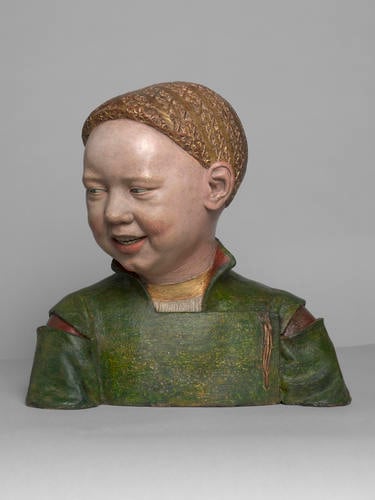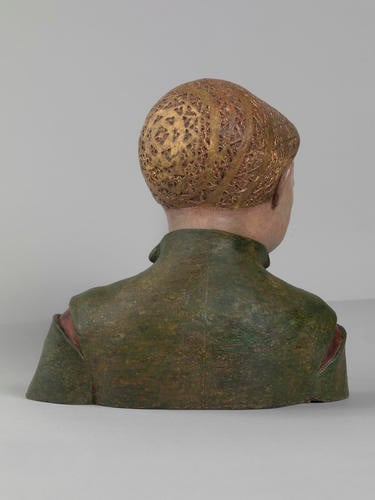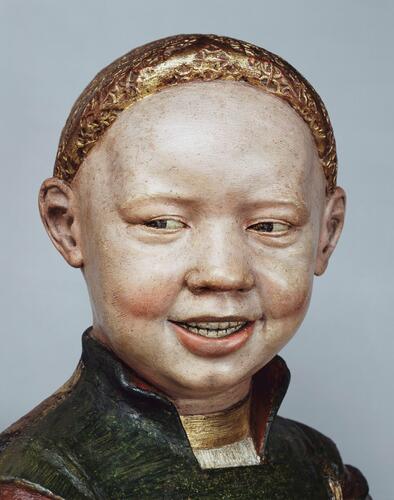-
1 of 253523 objects
Bust of a boy c. 1498
Painted and gilded terracotta | 31.8 x 34.3 x 15.2 cm (whole object) | RCIN 73197

Guido Mazzoni (c.1445 - d.1518)
Bust of a boy c. 1498

Guido Mazzoni (c.1445 - d.1518)
Bust of a boy c. 1498

Guido Mazzoni (c.1445 - d.1518)
Bust of a boy c. 1498



-
A life-size painted and gilded terracotta bust of a laughing young boy, looking with his head turned ¾ to the left, blue eyes, wearing a gilded net cap with a red lining and a dark tunic with gilt areas, held by a ribbon at the left shoulder, slashed at the shoulders to reveal a red undergarment and open at the neck revealing a white shirt. The green is achieved with a glaze over tin foil. The remaining areas are painted in oils.
This fragile bust seems to have remained in the Royal Collection since it was made. It is probably identifiable with the 'Head of a laughing boy' noted at Whitehall Palace in the reign of James II and in the Store Room at Whitehall Palace in an inventory made for William III; also with the 'Cast of a Chinese boy - laughing countenance' that was sent to Brighton Pavilion on 4 September 1815. It has subsequently been described as a laughing girl, a German dwarf, and as a portrait of Henry VIII (1491-1547) as a 7-year-old boy.
In 1925 Lionel Cust, Surveyor of the King's Pictures and Works of Art, attributed the bust to the Modenese sculptor Guido Mazzoni, also known as Paganino. By 1931 it was in the Holbein Room, Windsor Castle. Mazzoni's surviving work consists almost entirely of life-size painted terracottas of the same strikingly realistic character, forming groups of the Lamentation (Modena, San Giovanni Battista) and the Adoration of the Shepherds (Modena Cathedral) with typical individual teeth and narrow eyes or detailed clothing. A second, equally consistent mark of his work is a very high degree of technical proficiency, which is fully evident here. Paint analysis was carried out in 1964 and in 1985-8, when the bust was cleaned, and nineteenth-century overpaint was removed from the child's tunic, revealing the original scheme - a green glaze over an incised layer of tin foil, perhaps intended to imitate cloth of gold. It had been Cust who had previously studied the bust in 1901, when the dying Empress of Germany, sister to King Edward VII, had written to ask him from her deathbed where it was as she recalled it on a bookcase in the nursery at Buckingham Palace.
When Mazzoni was working on the tomb of the French King Charles VIII in Paris in the late 1490s, he submitted designs and an estimate for the tomb of Henry VII for Westminster Abbey, which were later rejected in favour of those by Pietro Torrigiano. The estimate does not indicate whether Mazzoni (who is called 'Master Pageny' in the English accounts) ever came to London, and no commission for the bust has come to light. Its identification as Prince Henry remains conjectural, supported only by its royal provenance and by the child's apparent age.
A campaign of examination in 1992 by John Larson established that it was probably made by pressing slabs of clay into a plaster piece-mould made from the original model. Two vertical bulkheads were placed inside the hollow of the bust, roughly in line with the armpits. The walls of the bust are no more than 5mm thick (very much thinner than is normal for terracotta of the period) and there is practically no evidence of damage during firing; the child's ears, nose and mouth are perforated to allow steam to escape in the kiln. The preservation of the bust over the course of five hundred years is extremely fortunate, especially given that it spent some years in store. The fact that since at least 1826 it has been covered by a glass shade has probably contributed to its survival. The painted surfaces have not fared as well. They were first examined in 1964 at the National Gallery, London, by Joyce Plesters, who found that while the paint on the face and most of the gilding of the hairnet seemed to be original, the whole of the bust had been repainted and gilded more than once. Plesters found cross section analysis of six different samples difficult to interpret because some layers were not distinct. Plesters did not find any eighteenth- or ninteenth- century pigments but Larson suggested that the black overpaint and gilded zig-zag band might date from its move to Brighton.
The bust inspired a painting, probably of the early seventeenth century, by an unknown artist with access to the royal palaces. This painting provides a reference of the appearance of the costume before it was overpainted (offered Dorotheum, Vienna, Autumn 2020 lot 242. Now Private Collection).
Catalogue entry adapted from Royal Treasures, A Golden Jubilee Celebration, London 2002 and Sculpture in the Collection of His Majesty The King, 2025.Provenance
Perhaps commissioned by or presented to Henry VII.
Exhibited at the Manchester Art Treasures Exhibition, 1862. -
Creator(s)
Acquirer(s)
-
Medium and techniques
Painted and gilded terracotta
Measurements
31.8 x 34.3 x 15.2 cm (whole object)
Alternative title(s)
Henry VIII (1491-1547) when a young boy (?)
Head of a laughing child
Place of Production
Europe